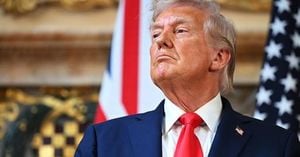The United States' decision to impose new restrictions on chip sales to China is sending ripples through the tech industry, raising major concerns and prompting intense debates about economic security, competitiveness, and political ramifications. These regulations have become particularly pivotal as tensions between the two superpowers intensify over trade and technology access.
Sources indicate the Biden administration is preparing final restrictions aimed at limiting China's access to advanced technology, particularly chips used for artificial intelligence (AI) applications. This move reflects mounting pressures to protect U.S. economic interests and national security, especially as concerns grow over alleged espionage and military advancements by China.
Initially, it seemed the curbs would be stringent, targeting several key players, including suppliers central to Huawei’s operations. Nevertheless, recent discussions suggest modifications to these anticipated restrictions, leading to uncertainty among corporations reliant on chip manufacturing and trade with China. This uncertainty has caused stock values, like Nvidia's, to fluctuate as analysts speculate about the forthcoming regulations.
For many, including industry leaders and policymakers, the goal of these measures is twofold: to curtail China's technological prowess and to safeguard the U.S.’s leading role as the major supplier of cutting-edge technology. Yet, others express concern about the broader economic consequences of such actions, fearing they could lead to retaliation from China or hinder American companies’ global competitive edge.
Compounding this complexity is the reality of the global semiconductor supply chain. It's intricately woven and cannot be easily unraveled. The U.S. relies on partnerships with overseas manufacturers, and disruptions to this supply chain could have severe consequences not just for technology firms but for consumers relying on chip-based devices. Analysts argue these restrictions could result in higher prices and slower technological advancement.
Recent reports indicate the Biden administration is likely opting for milder restrictions than previously expected, as negotiations and consultations with leading technology firms led to pressures for softening the rules. For example, ChangXin Memory Technologies, initially listed among those potentially facing increased scrutiny, has reportedly been excluded from the list of targeted entities under consideration.
This potential easing of restrictions has led firms like Nvidia to experience positive market reaction, as shares rose significantly following news from Bloomberg indicating the Biden administration may be reconsidering its stance. Nvidia saw its share price gain over 2%, as optimism about business prospects settled among investors tired of unpredictable trading conditions.
Other major semiconductor companies, such as Lam Research and Applied Materials, are anticipated to be less affected by these new rules. Their growth aligns closely with advancements and necessities of innovation, regardless of the regulatory environment, which places them at strategic advantage as global demand for chip technology continues to surge.
Complicatively, this scenario positions Washington at the intersection of technological leadership, economic opportunity, and geopolitical maneuvering. The U.S. must navigate its position carefully, balancing national security interests with economic prosperity and innovation leadership. The outcomes of these new restrictions could not only reshape the market dynamics but could also have larger ramifications for international relations and trade.
Industry experts argue the administration's next moves are consequential. If restrictions are perceived as too aggressive, this could not only escalate trade tensions with China but also provoke retaliatory measures. Such actions could potentially undermine U.S. businesses operating internationally, leading to prolonged tensions.
Meanwhile, the semiconductor market continues its remarkable growth, with forecasts projecting the global industry could reach upwards of $1 trillion by 2030, driven largely by demand from AI, automotive, and consumer electronics. This escalation heightens the importance of U.S. policy decisions as domestic companies strive to maintain, or even expand, their foothold within this lucrative sector.
On the other hand, countries beyond the U.S. may begin to pave their own paths, focusing on building independent supply chains, especially as China has invested considerably to develop its semiconductor industry. This push for self-reliance could lead to shifts within the industry, transforming global supply dynamics.
To counter this, U.S. companies will need to innovate diligently to stay competitive. The trade environment plays a significant role, so policy decisions must encourage growth without introducing stifling regulations. A pathways out of the dilemma could potentially include seeking multilateral solutions where countries can collaborate on technological innovation, ensuring both security and economic viability.
So, what's on the horizon for U.S. chip companies? The intense scrutiny and subsequent adjustments to restriction proposals reflect the necessity for balance between competition and collaboration. The semiconductor saga is sure to remain front and center as global tensions continue to evolve.
The world is watching closely as the Biden administration prepares to release its final ruling on these regulations next week. The stakes are high, not only for U.S. firms but also for international relations, as the new rules set the tone for the future of global technology diplomacy.



